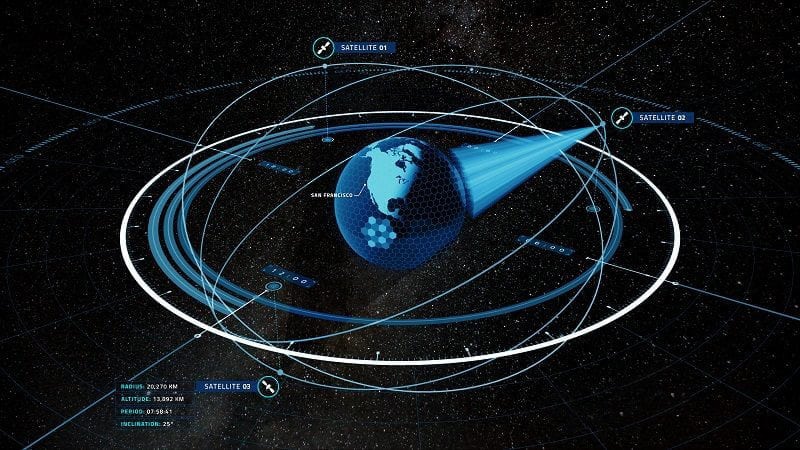Latest News

Audacy received a FCC license for commercial inter-satellite data relay network. Photo Credit: Audacy
It’s one small step for the aerospace players, but one giant leap for Audacy. The Silicon Valley startup has made news again. The last was in June, when the U.S. Federal Communications Commission (FCC) authorized a spectrum license allowing the space communications service provider to operate its inter-satellite data relay network. Now, news is that Audacy has secured pre-service commercial agreements valued at more than $100 million, marking a significant milestone for the company.
More than half of the agreements made are with U.S-based companies, while the rest spans Europe and Asia-Pacific, with the latter continuing to be an important growth market since Audacy opened its Singapore office last year. The pre-services commercial agreements cover the entirety of Audacy’s communications services, including applications for Non-Geostaionary Orbit (NGSO) Earth observation satellites, Internet of Things (IOT) and broadband constellations, launch vehicles, and deep space missions.
The pricing model, explained Audacy Chief Excutive Officer (CEO) Dr. Ralph Ewig, follows a pre-paid cell phone plan. Satellite operators purchase a certain amount of capacity in terabits, which they can use at any time or rate as needed.
“The mix includes anything from cubesats to launch vehicles and space stations,” said Ewig, adding that the company, as a market forerunner, is well positioned to impact communications standards. “In addition to gaining market share and becoming a technological leader, being a forerunner allows us to develop an open ecosystem that will enable the unhindered industry-wide expansion of human activities in space.”
Nowhere to go but up
Playing this role in setting communications standards as the first-to-market will also buoy the company to continue innovating and improving its capabilities, as new entrants add competition to this market. Demand for space data in Low Earth Orbit (LEO) is growing dramatically, and as many as 20,000 new satellites are projected to enter service in the next five years, said Ewig. While these LEO systems will all need a method for transmitting data back to the ground, the fact is that the focus will have to shift from expanding ground networks, where much of the current growth in space communications is fixed on, to space-based networks. With more than two-thirds of the Earth covered in water, spacecrafts can never achieve more than about 60 percent communications time, meaning that only space-based networks can achieve always-on coverage anywhere in LEO, said Ewig.
“Space-based networks are one aspect of the overall space communications infrastructure. There will always be a need for ground station networks, but there is room in the market for both options to exist in a symbiotic manner. However, our customer conversations indicate that satellite operators are increasingly more concerned with communications latency. That won’t change going forward, and there is no better solution than a space-based relay network. Once one operator, such as an Earth imaging company for example, starts utilizing real-time communications to enhance their business, others will have to follow suit to remain competitive,” he said.
In addition, real-time, always-on connectivity enables entirely new business models that are not possible with traditional ground-based solutions, noted Ewig. These include satellite servicing or comprehensive space situational awareness, for example.
“It’s a big and growing market with plenty of room for multiple providers. Additionally, with all these satellites becoming operational, spectrum will become even more of an issue than it is now. Solutions like Audacy that make the spectrum licensing process easier and more manageable have increasing value with each new LEO constellation proposed,” said Ewig, adding that he also sees growth for other parts of the industry value chain. “More satellites mean more launches, so the number of launch vehicles will grow as a direct result. There will also be a number of developments in debris management and space situational awareness,” he said.
Going beyond LEO
For now, Audacy is preparing for its ground teleports to be available for commercial use in early 2019, and its relay satellites are set to enter commercial service in 2020. However, the company will be expanding its ground and space segments by adding a teleport in Europe as well as additional relay satellites for more network throughput. Audacy will also begin exploring new coverage areas beyond LEO, possibly through NASA partnerships. Moreover, it will start building out additional services on top of communications, including positioning.
“By far, the launch of our relay satellites is the most important goal in our company. Leading up to that, we are looking to begin operations of our San Francisco and Singapore teleports next year and launch our third demo mission, Audacy One. On the business side, we are looking to continue our rapid pace in customer acquisition. The total addressable market for space communications will be about $10 billion by 2020, so there is a huge opportunity for us going forward,” Ewig concluded.
Stay connected and get ahead with the leading source of industry intel!
Subscribe Now